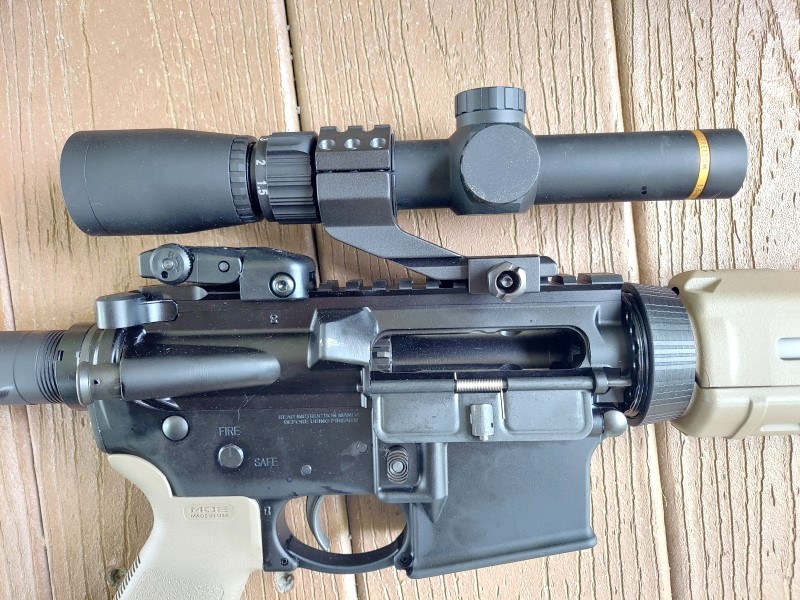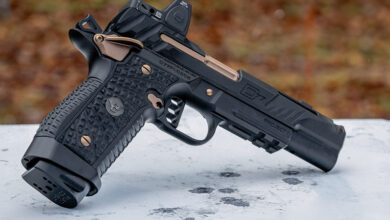Backup “Iron” Sights for the AR-15 Platform

Why would anyone bother using backup sights for their AR-15? How do they work? And are they truly useful?
We’ll give you the low-down on these low-profile sights and show you a few examples of quality offerings that won’t break the bank.
Why use them?
There are a few very good reasons to use Backup Iron Sights (BUIS). First, though, let’s point out a few misnomers in their name. They’re only “iron” as a historical reference, in that the standard sights of a firearm were normally metal or iron. These days, sights can be made from all sorts of materials, including polymer.
Secondly, although we call them backup sights, in some cases, these are the primary sights on the firearm. For instance, I have an AR-15 pistol, which isn’t legally intended to be fired from the shoulder, but that’s a whole different story. Having a set of iron sights on the pistol is acceptable legally. However, if I were to mount an optical sight that magnifies, then they consider it to be a dedicated, shoulder-fired weapon, so that’s a no-no.
As a result, I just threw a pair of iron sights on the weapon and called it a day. By the way, I’m not a lawyer, so take my legal explanation here with a grain of salt; this is the best way that I understand the rule, but I may have it wrong. Do some research on your own if you intend to go this route. At any rate, I digress. In short, sometimes they’re not “iron,” and sometimes they’re not “backup” sights; they are the primary sights.
Base Rifles
Some rifles on the market now don’t even include standard sights, leaving the decision of the sighting system up to the buyer. In other words, the top of the receiver is slick. Personally, I think AR-15s should come standard with at least some sort of sight up there, but not everyone shares my views.
In such cases, you’ll have to purchase front and rear sights of your own, which will add to the expense of the weapon. The upside is that you can add exactly the sights that you’d like. Plus, you can spend a little or spend a lot. It’s really your choice.
In Conjunction With Optics
Picatinny rails on the top of the receiver make mounting optics a breeze. Many mounts attach directly to the Picatinny rail, and it’s also easy to get quick-detachable mounts, so if the optic goes down, it can immediately be removed, and the backup iron sights can be employed. Originally, that was the major allure of these sights, and it still is.
In such a case, we’ll mount the backup sights on the receiver, along with an optic. In fact, I know a few people who have backup irons mounted in conjunction with a scope on their AR-15s.

Given the proper height on the scope, the BUIS can nestle underneath the optic’s ocular lens, tucked away until needed. Note that some rifles have a fixed front sight, while others will have no front sight at all from the factory. When there’s no front sight, you’ll have to add a front BUIS.
Choices. So many choices.
As mentioned, we’re going to throw out a couple of viable choices here so readers can peruse the options and figure out what’s the best choice for each rig. There are dozens of possibilities to choose from out there, but I have personal experience with the ones mentioned here, so I figured that I could describe them more accurately.
Midwest Industries
The Midwest Industries Flip-Up Rear Sight is a solid choice. It folds down out of the way, so it’s unobtrusive when not needed. I actually have this rear sight mounted on my AR-15 pistol’s Picatinny rail as the primary sight. It’s made of sturdy aluminum and features two apertures, the larger of which is intended for ranges from 0 to 200 yards. The aperture is protected by two very substantial ears.
Windage adjustments are made via a knob that looks just like the one on an M16A2, which is very easy to use. To fold the sight down, there is a detent button that must be pressed – otherwise, the sight remains locked in the upright position. This flip-up sight has a hard anodized finish, so it resists the elements well. I’ve used this sight for a number of years and have never been disappointed. As this is written, it sells for $104.99, but it’s a very solid, functional sight.

There is also a Midwest Industries Fixed Front Combat Sight, which attaches to a Picatinny rail at the front of the handguard. Essentially, it’s simply a removable M16A2/M4 front sight. It’s a very robust sight that can be adjusted just like a standard sight. As this is written, it sells for $62.99. Together, these two sights would make a great pair for a rifle or carbine.
Magpul Industries
The Magpul Rear Backup Sight is a popular one in the industry, and I see them on a fair share of the rifles that are out and about. This sight is simple, lightweight, and reasonably durable, not to mention modestly priced at $42.99. It has a convenient spring-up design, so the sight flips up when a lever is pressed on either side of the sight’s base. A cool feature is that there are both small and large apertures to look through. They are one unit, but if the user flips one down, the other is available. When you want the smaller aperture, they are both pressed together into one. There is a dial on the side of the sight that adjusts for windage, which is also very simple to use.

When folded into the low position, this sight is a mere .51 inches high and will attach to a Picatinny rail, which most rifles have these days. Its total weight is 1.3 ounces. If you’re going to tuck this in under a scope on your rifle’s rail system, it really works great for that.

Magpul also has a Front Backup Sight version, and it’s constructed similarly while barely weighing anything. As I write this, it sells for $32.99. It provides the same height over the bore as standard A2/M4 sights do and is adjustable for elevation. Like the rear sight, it will also fit a 1913 Picatinny rail.
Yankee Hill Machine
Yankee Hill Machine Company has a nice set of flip-up front and rear sights with a steel base and aluminum stem. They fold down when you push a button on the side of the sights and stay out of the way until needed. They are windage and elevation adjustable and simple to mount and use. I’ve actually used these sights in the past and can vouch that they are excellent. The price, at the time of writing, is $149.99.
Parting Thoughts
There are plenty of stowable backup sights on the market to choose from. As I mentioned, we just covered a few of them here, but it gives readers an idea of what’s out there, and they can expand their search if they desire.
Whether you’re using these sights as the primary sighting system for your rifle or emergency backups, they will perform well. As we’ve also seen, the prices run from fairly inexpensive to substantial. Having used the less expensive ones, I can tell you that they work just fine. The ones that cost a little more seem more robust and are a pleasure to use.
The post Backup “Iron” Sights for the AR-15 Platform appeared first on The Mag Life.
Read the full article here


![[FIRST LOOK] Strike Industries EMP With LED [FIRST LOOK] Strike Industries EMP With LED](https://firearm-discounts.com/wp-content/uploads/2024/12/SI-EMP-3-390x220.jpeg)



![Best 10mm 1911 Pistols [Field Tested] Best 10mm 1911 Pistols [Field Tested]](https://firearm-discounts.com/wp-content/uploads/2024/12/10mm-1911-feature-colt-delta-elite-390x220.jpg)